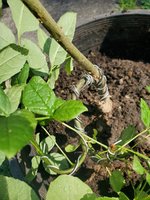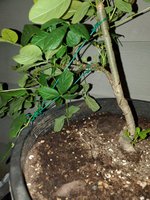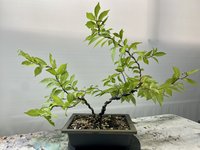First off wiring and growth. When one wires a bends a trees branches the plant cells get broken and or distorted. This slows or stalls growth in that region, depending on the severity of the bends. It takes a couple weeks to more then a month for this to resolve. The growth of the parts not wired are not under this handicap, the growth there continues unabated, or even accelerates temporarily.
Second. We really admire Dan Robinson, yet he is quite a bit unconventional. One has to take the best he has to offer and blend this in with the best others have to offer. Dan ancient and gnarly tree working techniques are not for everyone.
We recently wired two gnarly trees in a workshop with Dan this spring. He has his own way of wiring, doesn’t use copper and generally lays on wire as he sees fit. In the end it’s effective, yet can be pretty hard to look at and occasionally not so good for tree that needs to be conventionally aesthetically pleasing. Especially younger stock.
However his emphasis on use of guy wires whenever possible is spot on imho.
For beginners, or those that feel their wiring needs to be tuned up, Colin Lewis’s video is a good basic run.
However, after one has finished Colin Lewis’s wiring primer and practiced the basics on trees, I would recommend studying at a deeper level.
Structural wiring.
Basic structural wiring as applied to primary design.
Detail Wiring.
In depth detail wiring showing prep, theory and variations on secondary and tertiary detail wiring.
Have fun!
Cheers
DSD sends



